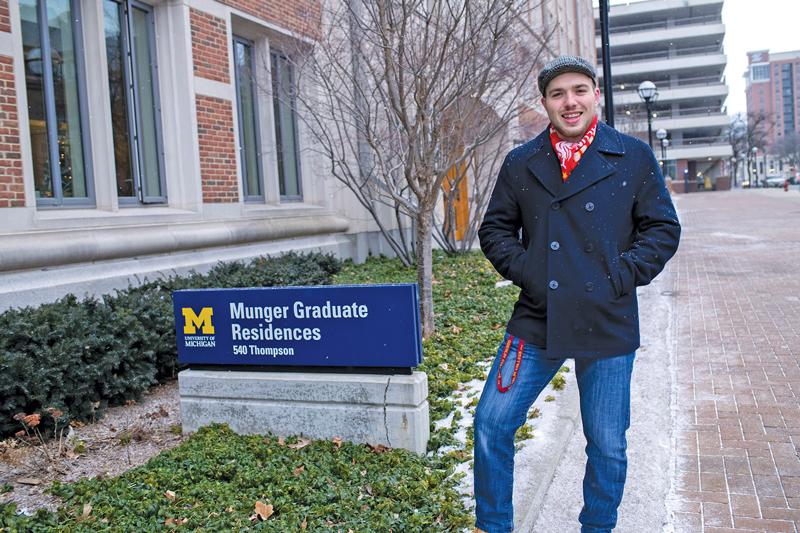That was the headline in a recent article in the New Yorker. “Charlie Munger, a Warren Buffett crony, donated two hundred million dollars to a university for a gigantic new dorm,” the subhead continued. “The catch: no windows. How did guinea pigs in a similar Munger housing experiment fare?”
The university in line for the money was the University of California-Santa Barbara. The “guinea pigs” were the residents of the U-M’s Munger Graduate Residences, which opened in 2015 on Thompson across from West Quad.
Writer Charles Bethea found plenty of zingers about the Santa Barbara plan, including the derisive nickname “Dormzilla,” fake windows inspired by Disney cruise ships, and a scathing resignation letter from an architect on the UCSB’s design review team. Calling it a “social and psychological experiment with an unknown impact on the lives and personal development of the undergraduates the university serves,” the architect declared it “unsupportable from my perspective as an architect, a parent and a human being.”
When the Observer wrote about the Ann Arbor dorm in 2015, the U-M hedged on who designed it. But Buffett–the legendary Berkshire Hathaway investor–publicly credited Munger. And like the planned UCSB building and another Munger residence at Stanford, most of the bedrooms are windowless.
Munger–who cut short his undergrad studies at the U-M to serve in WWII–wants to encourage “transdisciplinary learning” by bringing together students from different academic disciplines. The windowless bedrooms pack people in more efficiently–the Ann Arbor dorm houses 630 students–while the well-lit common areas are meant to draw them out of their rooms to mingle.
Amir Baghdadchi, senior associate director of U-M Housing, says Munger is the only U-M dorm with windowless bedrooms. But residents, he says, are “at most thirty seconds” away from large common areas in their apartments, and a shared common area on the eighth floor is lined with windows opening onto small and large study spaces.
So is cross-disciplinary learning happening? The New Yorker article suggests not. Bethea quoted a former resident, Wilson Chen, who lived there for four years without even realizing there was a “window theory.” “Everyone I knew just kept to themselves,” Chen said.
Chen grudgingly got used to sleeping in total darkness, but the magazine quoted another resident, Matthew Moreno, who chose instead to sleep in the (windowed) common area.
The least happy camper, though, was Luiza Macedo, who talked to CNN for its own story on the building.
Macedo didn’t respond to emails from the Observer, but according to CNN, she didn’t see the sun for a full week when she had to isolate in her room at Munger Residence due to a Covid-19 scare. “A lot of people are incredulous that this was even a thing,” she was quoted as saying, “like, how is this legal?” (Ann Arbor code compliance officer Chris MacFarland says that the state building code allows windowless spaces as long as they have sufficient artificial light and ventilation.)
“I really enjoyed the dark,” says Anthony Allen, a chemistry grad student who lived in Munger for three years. “I go to bed when it’s dark, and I typically wake up at 5:45 a.m., so it’s almost always dark [anyway].”
Allen was an exception. A lot of his roommates, he says, had seasonal affective disorder and “would buy alarm clocks that would mimic the rising sun … the LED would brighten with time to create artificial sunlight in the room.”
That worked for Allen’s former suitemate Samuel Chung, who was getting his master’s in accounting at the Ross business school. A friend gave him one that gradually grew brighter starting half an hour before the alarm time. “Often, before that half-hour was up, I would already be woken up.”
Like Allen, physics PhD student Patrick Barnes eventually got used to not having a window in his bedroom. And as Munger hoped, he spent most of his time in the common area. When his office closed during the pandemic, he was there for ten to twelve hours a day. “There are two fridges there, a couple ovens, dishwashers, and there’s a very sizable living room,” he says. “There were a couple couches, a few chairs, a couple tables, a few TVs, and there are a lot of big windows, so that’s nice.”
Current resident Arjun Lama, who’s getting a master’s in management at Ross, spends “a decent amount of time” in the suite’s common area, but more “in the study rooms in the basement and the eighth floor. I have a large group of friends that are from my program who also live in Munger, so we do things in the common areas like play board games and use the movie theater.”
The review site veryapt.com ranks apartments on a ten-point scale. Munger is an 8.3, based on 123 ratings. It hard to make comparisons because some buildings have only one or two reviews, and only a handful have more than 100. But among those, Munger is second only to 618 N. Main, at 9.0. Munger’s reviewers note that the lack of windows might “scare” some people, and that common spaces are often “crowded,” but most praise the amenities and the central location.
Munger, ninety-seven, brushed off the criticism. Bethea quoted his response in Architectural Record to the architect who denounced his UCSB design: the philanthropist called him “an ‘idiot’ who didn’t ‘look at the building intelligently.'”
But to CNN, he did admit that the first Munger residence could have been better. “It was a mistake on my part, not to put these artificial windows into Michigan,” he said.


